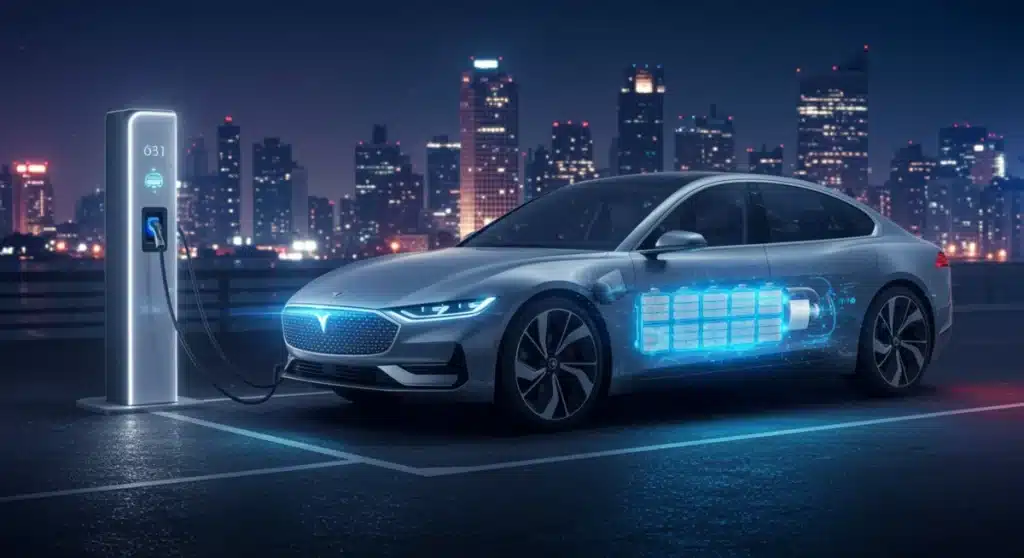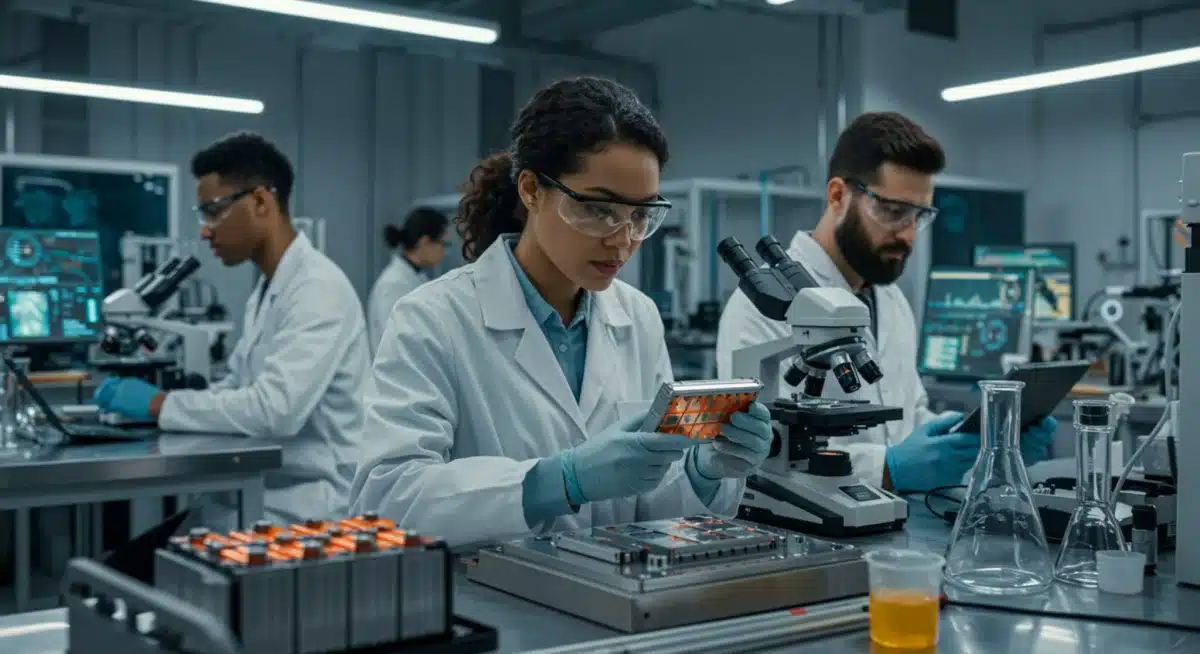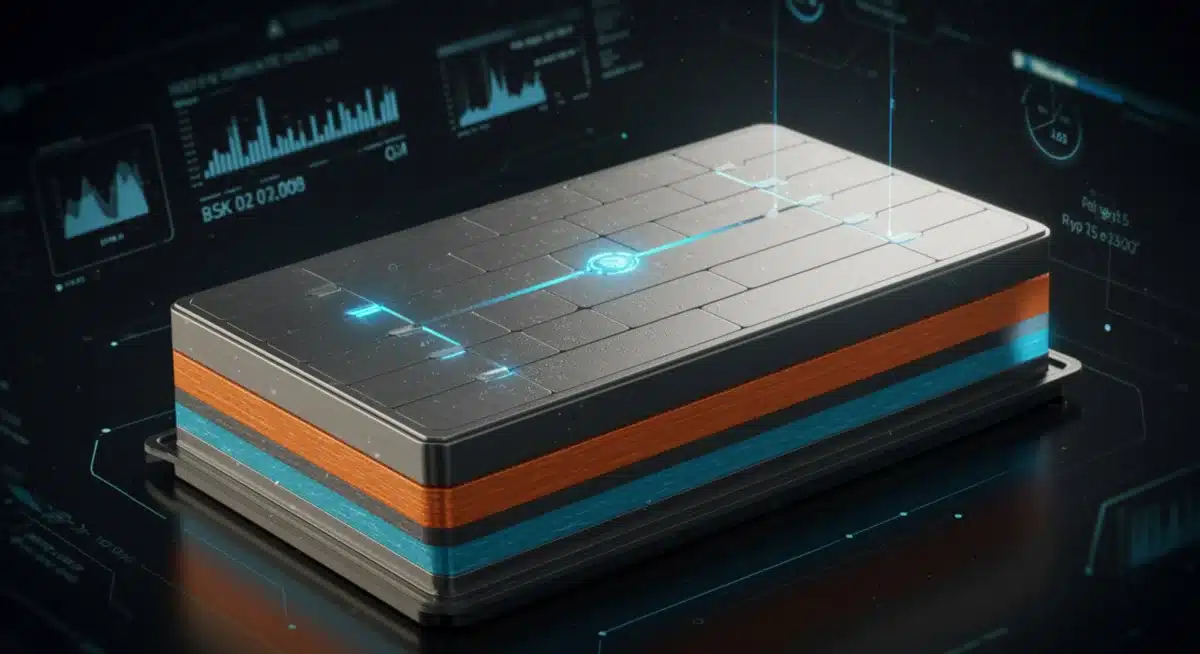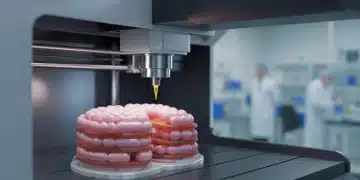US Battery Tech: Powering the EV Revolution

US innovation in battery technology is driving the electric vehicle revolution by developing advanced solutions that enhance energy density, accelerate charging times, and improve overall sustainability for a greener future.
The electric vehicle (EV) revolution is no longer a distant dream but a rapidly unfolding reality, and at its core lies the relentless pursuit of superior battery technology.
The United States, with its robust ecosystem of research institutions, innovative startups, and established automotive giants, is at the forefront of this transformation,
spearheading Breakthrough Battery Technology: How US Innovation is Powering the Electric Vehicle Revolution.
This dynamic landscape of scientific discovery and engineering prowess is not only redefining how we power our vehicles but also shaping the very future of sustainable transportation.
The Foundation of the EV Revolution: Lithium-ion Advancements
Lithium-ion batteries have been the workhorse of the EV industry for years, offering a compelling balance of energy density and cycle life.
However, the demand for greater range, faster charging, and enhanced safety has pushed US innovators to continually refine and reimagine this foundational technology.
From optimizing electrode materials to developing more stable electrolytes, the focus remains on pushing the boundaries of what lithium-ion can achieve.
These incremental, yet significant, improvements are crucial for widespread EV adoption.
The pursuit of higher energy density in lithium-ion batteries is a key area of research, as it directly translates to extended driving range for electric vehicles.
Researchers are exploring novel cathode and anode materials that can store more energy within a smaller volume and weight.
This includes silicon-based anodes, which theoretically offer a significantly higher capacity than traditional graphite, and nickel-rich cathodes that can pack more energy per unit mass.
Overcoming the challenges associated with these materials, such as volume expansion in silicon and thermal stability in high-nickel cathodes, is a primary goal for US scientists and engineers.
Enhancing Charging Speeds and Battery Longevity
- Advanced Anode Materials: Investigating silicon-carbon composites and other nanostructured materials for faster lithium-ion intercalation.
- Electrolyte Engineering: Developing solid-state electrolytes or highly conductive liquid electrolytes to minimize internal resistance and allow for higher charging currents.
- Thermal Management Systems: Designing sophisticated cooling systems to dissipate heat efficiently during rapid charging, preventing degradation and ensuring safety.
Beyond energy density, the ability to charge an EV quickly and reliably is paramount for consumer acceptance.
US companies and academic institutions are investing heavily in technologies that enable ultra-fast charging without compromising battery health or safety.
This involves not only modifications to the battery chemistry but also advancements in battery management systems (BMS) that intelligently control the charging process.
The goal is to achieve charging times comparable to refueling a gasoline car, making EVs a more convenient option for long-distance travel.
Furthermore, extending the lifespan of EV batteries is critical for reducing total cost of ownership and minimizing environmental impact.
Research into self-healing materials and advanced diagnostic tools is contributing to batteries that can withstand thousands of charge cycles without significant capacity loss.
The Promise of Solid-State Batteries: A Game Changer
While lithium-ion batteries continue to evolve, the true next-generation breakthrough many anticipate is the widespread adoption of solid-state batteries.
These batteries replace the flammable liquid electrolyte with a solid material, offering significant advantages in safety, energy density, and potentially faster charging speeds.
US companies and research consortiums are leading the charge in developing viable solid-state battery technology, attracting substantial investment and talent.
The potential to revolutionize the EV market is immense, promising vehicles with longer ranges, reduced weight, and enhanced reliability.

The transition from liquid to solid electrolytes eliminates the risk of thermal runaway and fire, a major safety concern with current lithium-ion batteries.
This inherent safety allows for greater design flexibility and potentially higher energy densities, as cells can be packed more tightly.
Moreover, solid-state batteries are expected to offer a much longer cycle life, meaning they can be charged and discharged many more times before significant degradation occurs.
This longevity is crucial for second-life applications and overall sustainability.
Challenges and Progress in Solid-State Development
Despite their promise, solid-state batteries face considerable manufacturing challenges.
Achieving good ionic conductivity in solid electrolytes at room temperature, ensuring stable interfaces between electrodes and the solid electrolyte, and scaling up production to meet automotive demands are complex hurdles.
However, US-based startups and established research institutions are making significant strides in these areas.
Breakthroughs in solid electrolyte materials, such as sulfide-based ceramics and polymer-based composites, are paving the way for commercialization.
Pilot production lines are already demonstrating the feasibility of manufacturing these advanced cells, with some experts predicting market entry within the next few years.
- Material Science Innovation: Developing new solid electrolyte compounds with high ionic conductivity and mechanical stability.
- Interface Engineering: Solving the challenge of maintaining low resistance contact between solid electrodes and electrolytes.
- Manufacturing Scalability: Designing cost-effective and high-throughput production processes for solid-state battery cells.
The collaborative efforts between academia, government labs, and private industry in the US are accelerating the pace of solid-state battery development.
This synergy is critical for overcoming the remaining technological and manufacturing barriers.
The potential impact on the EV market, and indeed on energy storage across various sectors, is so profound that it justifies the intensive research and investment currently underway.
The successful deployment of solid-state technology would mark a true paradigm shift in energy storage.
Beyond Lithium: Exploring Alternative Battery Chemistries
While lithium-ion and solid-state batteries dominate current discussions, US innovation is also exploring alternative battery chemistries that could offer unique advantages or address specific limitations of lithium.
These alternatives often utilize more abundant and less costly materials, potentially reducing geopolitical dependencies and environmental impacts.
Sodium-ion, zinc-air, and flow batteries are among the promising candidates attracting significant research attention.
Sodium-ion batteries, for instance, utilize sodium, a far more abundant element than lithium, making them potentially cheaper and more sustainable.
While their energy density is currently lower than lithium-ion, advancements in electrode materials and cell design are rapidly closing this gap.
US research is focusing on improving their cycle life and energy efficiency to make them viable for certain EV segments or stationary storage applications.
Zinc-air batteries, another area of interest, offer very high theoretical energy densities and use readily available zinc and oxygen.
The challenge lies in making them rechargeable and optimizing their power output, but their potential for long-duration applications is significant.
The Role of Flow Batteries in Grid Stability and EV Charging
- Enhanced Safety: Non-flammable electrolytes make flow batteries inherently safer for large-scale applications.
- Scalable Storage: Energy capacity can be scaled independently of power, by simply increasing the volume of electrolyte.
- Long Lifespan: Electrolyte degradation is minimal, allowing for thousands of charge-discharge cycles without significant capacity loss.
Flow batteries, though not directly powering EVs, play a crucial indirect role in the EV ecosystem by providing grid-scale energy storage.
As more EVs come online, the demand for electricity will rise, and renewable energy sources will need reliable storage solutions to ensure grid stability.
US companies are developing advanced flow battery chemistries that can store large amounts of energy for extended periods, enabling the integration of intermittent renewables like solar and wind.
This ensures that EV charging infrastructure is powered by clean, consistent energy, further accelerating the decarbonization of transportation.
The research into these diverse chemistries highlights a forward-thinking approach, ensuring a robust and resilient energy future beyond a single dominant technology.
Manufacturing and Supply Chain Resilience in the US
Beyond scientific breakthroughs, the US is making concerted efforts to build a resilient domestic supply chain for battery manufacturing.
Reducing reliance on foreign sources for critical minerals and battery components is a strategic imperative, driven by economic security and national interest.
New Gigafactories are being established across the country, creating jobs and fostering an ecosystem for advanced battery production.
This localized manufacturing capacity is essential for ensuring the scalability and cost-effectiveness of next-generation battery technologies.
The US government is actively supporting these initiatives through incentives, grants, and strategic partnerships.
The goal is not only to produce batteries but also to process raw materials domestically, from mining to refining.
This vertical integration strengthens the entire supply chain, making it less vulnerable to global disruptions and price volatility.
Furthermore, investing in domestic manufacturing capabilities ensures that the intellectual property and expertise developed in US labs translate directly into tangible economic benefits and technological leadership.
This holistic approach addresses both the innovation and industrialization aspects of the battery revolution.
Key Initiatives for Domestic Battery Production
- Gigafactory Development: Significant investments from major automakers and battery manufacturers to establish large-scale production facilities in the US.
- Critical Mineral Sourcing: Efforts to identify and develop domestic sources of lithium, nickel, cobalt, and other essential battery minerals, alongside ethical sourcing from allies.
- Recycling and Reclamation: Investing in advanced battery recycling technologies to recover valuable materials, reducing the need for new mining and minimizing waste.
The development of a robust domestic battery manufacturing base also has profound implications for national security.
By controlling more aspects of the battery supply chain, the US can reduce its vulnerability to geopolitical pressures and ensure access to essential components for both commercial and defense applications.
This strategic focus on self-sufficiency is a defining characteristic of the US approach to powering the EV revolution.
The combination of cutting-edge research and industrial policy is creating a powerful engine for growth and innovation, positioning the US as a global leader in battery technology.
Sustainable Battery Solutions: A Circular Economy Approach
The environmental impact of battery production and disposal is a critical consideration in the drive towards sustainable transportation.
US innovators are not only focusing on performance but also on developing battery technologies and processes that minimize their ecological footprint.
This includes research into more environmentally friendly materials, energy-efficient manufacturing techniques, and robust recycling programs.
The vision is a circular economy for batteries, where materials are reused and repurposed, reducing waste and conserving resources.

Recycling plays a pivotal role in this sustainable vision.
Advanced recycling technologies are being developed in the US to efficiently extract valuable metals like lithium, cobalt, and nickel from spent EV batteries.
These recovered materials can then be used to produce new batteries, significantly reducing the energy and environmental costs associated with virgin material extraction.
Beyond recycling, the concept of ‘second-life’ applications for EV batteries is gaining traction.
Batteries that no longer meet the performance requirements for vehicles can still be perfectly suitable for stationary energy storage, such as powering homes or grid infrastructure.
This extends their useful life and maximizes their value before eventual recycling.
Innovations in Sustainable Battery Design
- Cobalt-Free Chemistries: Research into cathode materials that eliminate or significantly reduce the need for cobalt, a metal often associated with ethical sourcing concerns.
- Aqueous Electrolytes: Developing water-based electrolytes that are less toxic and non-flammable compared to organic solvents.
- Modular Battery Packs: Designing battery packs that are easier to disassemble, repair, and recycle, simplifying the end-of-life process.
Furthermore, US research is exploring ways to reduce the energy intensity of battery manufacturing itself.
This includes optimizing production processes to use less electricity and water, and developing new methods for material synthesis that require lower temperatures or fewer harsh chemicals.
The focus on sustainability extends to every stage of the battery lifecycle, from raw material extraction to end-of-life management.
By integrating environmental considerations into the core of battery innovation, the US is not only driving technological progress but also setting new standards for responsible industrial development.
This commitment to a circular economy ensures that the EV revolution is truly green from start to finish.
The Economic and Societal Impact of US Battery Innovation
The advancements in US battery technology are creating profound economic and societal impacts, extending far beyond the automotive industry.
The growth of the battery sector is generating new jobs, fostering economic development in various regions, and attracting significant investment.
This burgeoning industry is becoming a cornerstone of the modern economy, driving innovation in related fields and creating new opportunities for skilled labor.
Economically, the domestic production of advanced batteries reduces reliance on foreign suppliers, strengthening national economic security.
The creation of new manufacturing facilities, research and development centers, and recycling plants contributes to job growth across a spectrum of professions, from engineers and scientists to technicians and factory workers.
This economic activity is revitalizing communities and establishing new industrial hubs focused on clean energy technologies.
The ripple effect extends to ancillary industries, such as charging infrastructure development, material suppliers, and software solutions for battery management.
Societal Benefits of Advanced Battery Technology
- Cleaner Air: Reduced emissions from internal combustion engines lead to improved air quality in urban areas, benefiting public health.
- Energy Independence: Less reliance on fossil fuels, enhancing national energy security and reducing exposure to volatile global oil markets.
- Technological Leadership: The US positioning itself as a leader in battery innovation fosters a culture of scientific inquiry and technological advancement, inspiring future generations.
Societally, the widespread adoption of EVs, powered by advanced US battery technology, leads to a significant reduction in greenhouse gas emissions, directly combating climate change.
Cleaner air in cities improves public health, reducing respiratory illnesses and other environmental health issues.
Furthermore, the transition to electric vehicles contributes to energy independence, as electricity can be generated from diverse domestic sources, including renewables, reducing reliance on imported oil.
This fundamental shift not only benefits the environment but also provides greater stability and predictability in energy costs for consumers.
The overall impact is a more sustainable, healthier, and economically robust future for the nation.
The Road Ahead: Future Horizons in Battery Development
The journey of battery innovation is far from over.
US researchers and companies are already looking beyond current horizons, exploring even more radical concepts that could further transform energy storage.
From quantum-dot batteries to self-assembling molecular structures, the quest for the ultimate energy storage solution continues unabated.
The future promises batteries that are not only more powerful and sustainable but also seamlessly integrated into our daily lives, powering everything from our vehicles to our smart homes and cities.
One exciting area of future research involves artificial intelligence and machine learning to accelerate material discovery and optimize battery performance.
AI can rapidly screen millions of potential compounds, predicting their properties and guiding experimental design, significantly shortening the development cycle for new battery chemistries.
Another frontier is the development of ultra-flexible and printable batteries, which could enable new applications in wearable electronics, smart textiles, and even structural components of vehicles.
These advancements promise to make energy storage more adaptable and ubiquitous.
Emerging Battery Concepts and Long-Term Goals
The long-term vision includes batteries that are truly ‘smart,’ capable of self-diagnosis, self-repair, and dynamic adaptation to varying operating conditions.
Imagine batteries that can communicate their state of health, predict their remaining lifespan, and even adjust their internal chemistry to optimize performance or extend their life.
Such intelligent energy storage systems would revolutionize not just EVs but also grid management and portable electronics.
The continuous investment in fundamental science and engineering in the US is laying the groundwork for these transformative technologies.
- AI-Driven Material Discovery: Using computational methods to accelerate the identification and optimization of new battery materials.
- Quantum Battery Research: Exploring quantum mechanical principles to achieve unprecedented energy densities and charging speeds.
- Structural Batteries: Integrating energy storage directly into the physical structure of vehicles or devices, reducing weight and maximizing space efficiency.
The collaborative spirit among national labs, universities, and private industry in the US is a powerful catalyst for these future innovations.
By fostering an environment of open research and rapid prototyping, the US is poised to maintain its leadership in battery technology for decades to come.
The breakthroughs currently in the pipeline promise to deliver an even more efficient, sustainable, and powerful future for electric vehicles and beyond, cementing the US’s role as a global pioneer in clean energy solutions.
| Key Aspect | Description |
|---|---|
| Lithium-ion Evolution | Continuous US innovation in energy density, charging speed, and longevity for current EV batteries. |
| Solid-State Promise | Next-gen US development for safer, higher energy density, and faster-charging EV batteries. |
| Supply Chain Resilience | US efforts to localize battery manufacturing and critical mineral processing for economic security. |
| Sustainable Practices | Focus on recycling, second-life applications, and eco-friendly battery materials in US innovation. |
Frequently Asked Questions About US Battery Innovation
US innovation primarily focuses on enhancing lithium-ion battery performance, developing solid-state batteries for improved safety and energy density, exploring alternative chemistries like sodium-ion, and building a resilient domestic manufacturing supply chain for sustainability and economic security.
Solid-state batteries replace the flammable liquid electrolyte of lithium-ion batteries with a solid material. This change promises greater safety, higher energy density for longer ranges, and potentially faster charging, representing a significant leap forward in battery technology.
Domestic manufacturing is crucial for US battery innovation as it reduces reliance on foreign supply chains, creates jobs, and fosters economic growth. Building Gigafactories and processing critical minerals domestically ensures scalability, cost-effectiveness, and national security in battery production.
Sustainability is a core focus, with US innovation emphasizing advanced recycling techniques to recover valuable materials, promoting ‘second-life’ applications for used EV batteries, and researching eco-friendly battery chemistries and manufacturing processes to minimize environmental impact.
Future prospects include leveraging AI and machine learning for rapid material discovery, developing quantum batteries for unprecedented performance, and integrating structural batteries into vehicle designs. The goal is smarter, more powerful, and seamlessly integrated energy storage solutions for diverse applications.
Conclusion
The ongoing advancements in US battery technology are undeniably the driving force behind the accelerating electric vehicle revolution.
From the continuous refinement of lithium-ion chemistries to the promising emergence of solid-state solutions and the exploration of diverse alternatives,
US innovation is tackling critical challenges in energy density, charging speed, safety, and sustainability.
Coupled with a strategic push for domestic manufacturing and a commitment to a circular economy, these efforts are not only transforming the automotive industry but also creating significant economic opportunities and fostering a cleaner, more energy-independent future for the nation.
The relentless pursuit of scientific excellence and engineering ingenuity positions the United States at the vanguard of global energy storage advancements,
promising a future where electric vehicles are not just a viable alternative, but the preferred mode of transportation.





